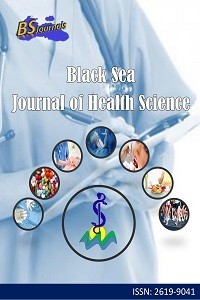Sample Size in Clinical Researches: Power of the Test and Effect Size
Sample Size in Clinical Researches: Power of the Test and Effect Size
___
- Anonymous 2020a URL: https://www.titck.gov.tr/faaliyetalanlari/ilac/klinik-arastirmalar (access date: September 20, 2020).
- Anonymous 2020b. URL: https://ikua.saglik.gov.tr/TR,259729/klinik-arastirma-nedir.html, (access date: September 20, 2020).
- Cohen J. 1988. Statistical power analysis for the behavioral sciences. Hillsdale, Lawrence Erlbaum Associates, New Jersey, USA, 567 pages.
- Faul F, Erdfelder E, Lang AG, Buchner A. 2007. G*Power 3: A flexible statistical power analysis program for the social, behavioral, and biomedical sciences. Behav Res Methods, 39(2): 175-191.
- Faul F, Erdfelder E, Buchner A, Lang AG. 2009. Statistical power analyses using G*Power 3.1: Tests for correlation and regression analyses. Behav Res Methods, 41(4): 1149-1160.
- Kalaycıoğlu O, Akhanlı SE. 2020. Sağlık araştırmalarında güç analizinin önemi ve temel prensipleri: Tıbbi çalışmalar üzerinde uygulamalı örnekler. Turk J Public Health, 18(1): 103-112.
- Yayın Aralığı: Yılda 4 Sayı
- Başlangıç: 2018
- Yayıncı: Cem TIRINK
Şerife YILMAZ, Meltem BÜYÜKÖZTÜRK
Internet Addiction among Secondary School Students Conditioned By Gender and Age
Igor LUKİĆ, Nikola SAVİĆ, Ivana VUKOSAVLJEVİĆ, Nevena RANKOVİĆ, Dragica RANKOVİĆ
Pelvik Kuşak Ağrısında Klinik Testler ile Hasta Bildirimli ve Performansa Dayalı Sonuç Ölçümleri
Semiha KADIOĞLU, Yasemin ERTAŞ ÖZTÜRK
Comparison of Refractive Changes Following Pseudophakic Vitrectomy with or without Gas Tamponade
Sami YILMAZ, Ayşegül MAVİ YILDIZ, Mehmet Emin ASLANCI, Remzi AVCI
Stereolojik Bir Araştırma: Akciğer Hacmi ve İzdüşüm Yüzey Alanı Arasındaki İlişki
Aysun YAĞCİ ŞENTÜRK, Ayşen TASLAK ŞENGÜL, Bümyamin ŞAHİN, Ahmet BAŞOĞLU
Disabled Children and Communication
Nazlı Melis MİSYAĞCI, Çiğdem Müge HAYLI
COVID-19 Pnömonisi - Brusella spp. Koenfeksiyonu : Olgu Sunumu
Emine Kübra DİNDAR DEMİRAY, Hanife Nur KARAKOÇ, Hacer AKŞİT, Erdinç EREN, Özgür PAŞA, Gökhan ŞAHİN, Ömer DURAN, Fadime GÜLPINAR, Saadet YILDIRIM, Edip YILDIZ, Eren BEKTAŞ
